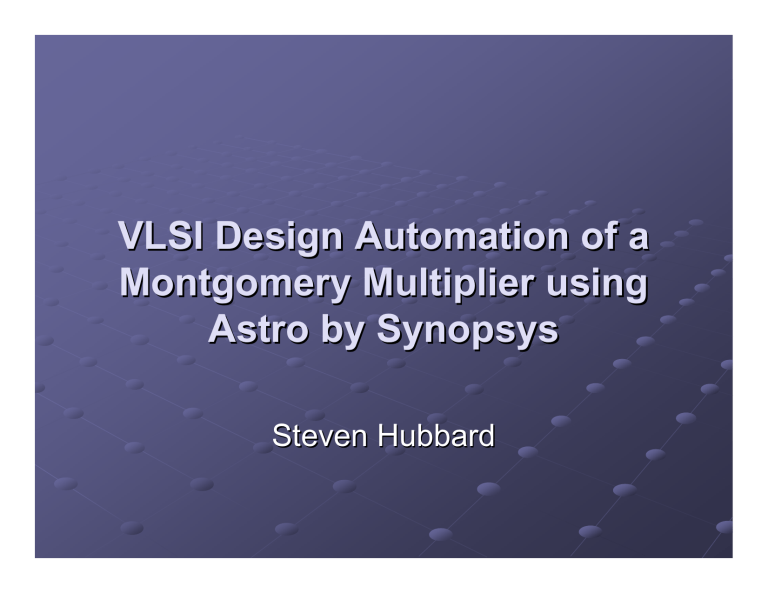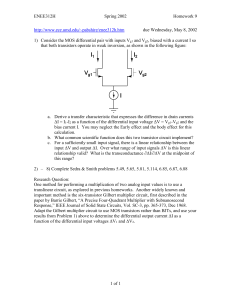VLSI Design Automation: Montgomery Multiplier with Synopsys Astro
advertisement

VLSI Design Automation of a Montgomery Multiplier using Astro by Synopsys Steven Hubbard Overview Montgomery Multiplier for RSA Encryption Physical Design – ASIC and SoCs ASIC Advantages Astro Place and Route by Synopsys Montgomery Multiplier Circuit Synthesis Results RSA Public-Key Cryptosystem Developed by Rivest, Shamir, and Adleman in 1978 Private Key contains two large prime numbers, p and q, as well as a secret exponent d Public Key consists of n = p * q, with exponent e Requires Modular Exponentiation Decryption involves larger exponentiation Montgomery Multiplication Efficient technique for computing modular exponentiations Does not require division in taking modulus Replaces with bit shifting, which is fast and easy in hardware Simple conversion to Montgomery Domain done before and after Multiplication Very Large Scale Integration (VLSI) Computer Aided Design of Complex Circuits Tools for VLSI Produced by Synopsys Used for Application Specific Integrated Circuits (ASIC) and Systems On Chips (SoCs) Application Specific Integrated Circuits (ASIC) Advantages Speed Area Power Consumption Disadvantages Manufacturing Time (FPGA time about half) Cost Astro – Place and Route Tool Creates Physical Design Layout Uses 3 Primary Inputs Gate Level Netlist from Verilog Standard Cell Library of Target Technology Also contains timing information for the cells Design Constraints (SDC File) Clock Speeds Input / Output Delays Astro Tutorial Provided by Synopsys Primary Resource for Project Tutorial Version: 3.6 Designed for Astro Version: 2003.09-SP1 Astro Version in Lab: 2004.06-SP1 Used same steps for Montgomery Multiplier Circuit Synthesis Astro Tutorial Consists of 12 section which step through place-and-route and other tools. Not all sections used, not needed for circuit. Will be a primary resource for ECE 681 – VLSI Design Automation class. Montgomery Multiplier Circuit Synthesis VHDL Code Provided by Hoang Le Montgomery Multiplier Used in Elliptic Curve Method Circuit Use Design Analyzer in on Unix Server to convert to Verilog and create SDC Timing File Montgomery Multiplier Circuit Synthesis – Library and Cell Creation First steps in Astro Create Library Expand Netlist from Verilog Code Link Technology files and Reference Library Technology File - designs.tlu.18.tf Reference Library - tcbn90g 90 nm circuit Load Timing Constraints from SDC File Montgomery Multiplier Circuit Synthesis – Library and Cell Creation Create Cell Power / Ground Ring P/G Strap Standard Cells Montgomery Multiplier Circuit Synthesis – Optimizations and Placement Pre and Post Placement Optimization Frequent Optimizations run throughout process to lower delay and verify design Place Blocks Arrange Standard Cells Create Clock Tree Synthesis Drive all clocked components without connecting them to a single port. Multiplier Cell after Placement Montgomery Multiplier Circuit Synthesis – Routing Routing the Design Connect Cells with Metal More Optimization Design Checks Cross Talk Check that signals will not affect adjacent wires Multiplier Cell after Routing Additional Astro Tools ECO Update circuit without recreating entire layout Netlist Verification using Formality Verify that the input and output Netlist are the same Astro Rail Create Voltage Drop Map and Electromigration Map Static Timing Analysis using Primetime Signoff quality static timing analysis and delay calculation Multiplier Clock Tree Multiplier Voltage Drop Map Montgomery Multiplier Circuit Synthesis – Timing Reports Based on SDC file Generated Throughout Process Usually Changes with optimization and analysis Show delay, report in terms of “Slack” Difference between required delay and actual delay Steps through Critical Path Montgomery Multiplier Timing Results Three Synthesis Cases 10 ns delay 5 ns delay 2.5 ns delay Same circuit run on FPGA at 200 MHz or 5ns delay Montgomery Multiplier Timing Results Slack Total Delay 10 ns Delay 3.7089 6.2911 5 ns Delay 0.1477 4.8523 -2.1415 4.6415 2.5 ns Delay Conclusions Powerful Tool to create Physical Layouts Need to Analyze Critical Path to see if speed can be increased Does not look like good Circuit Structure for ASIC Questions ?

